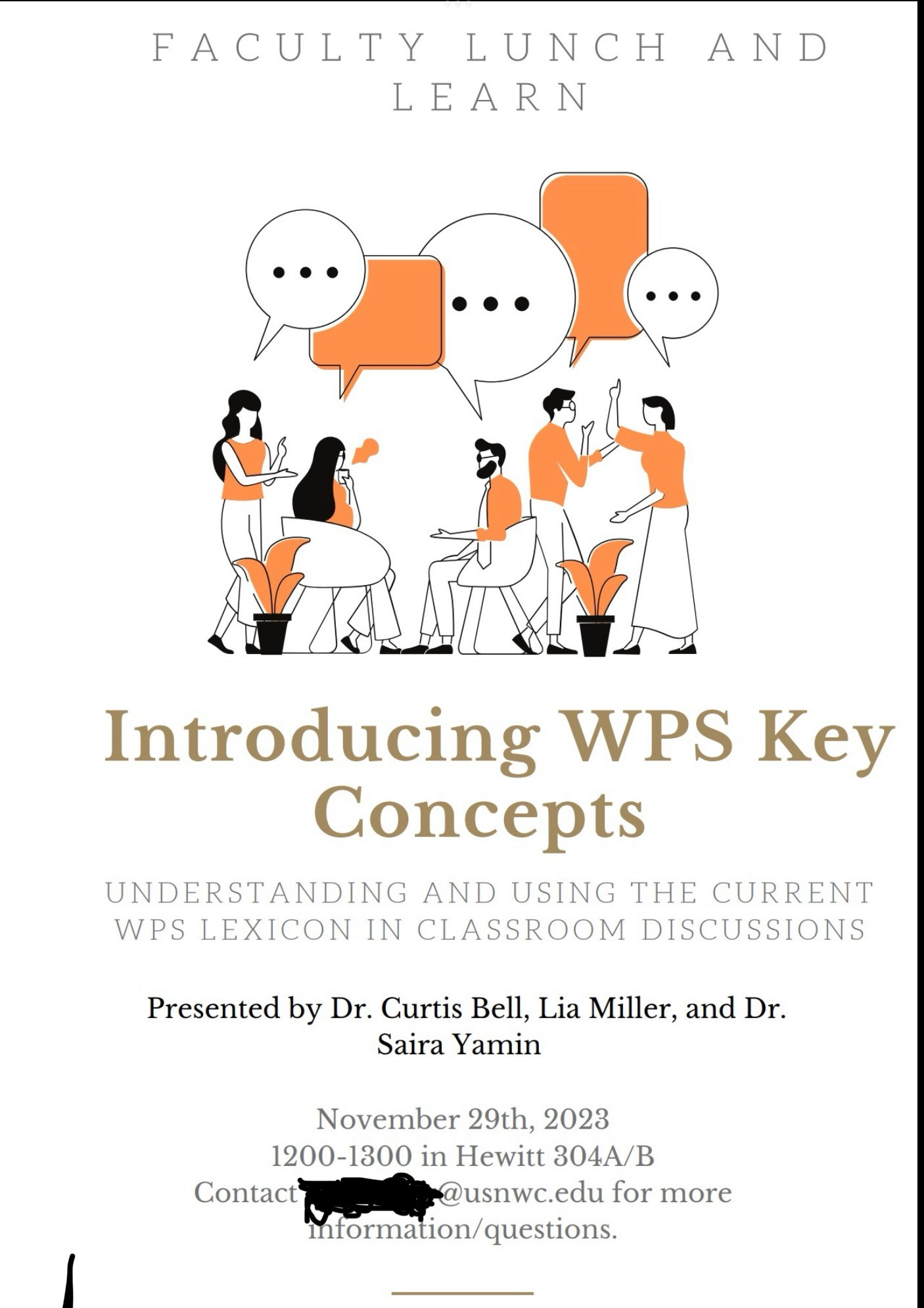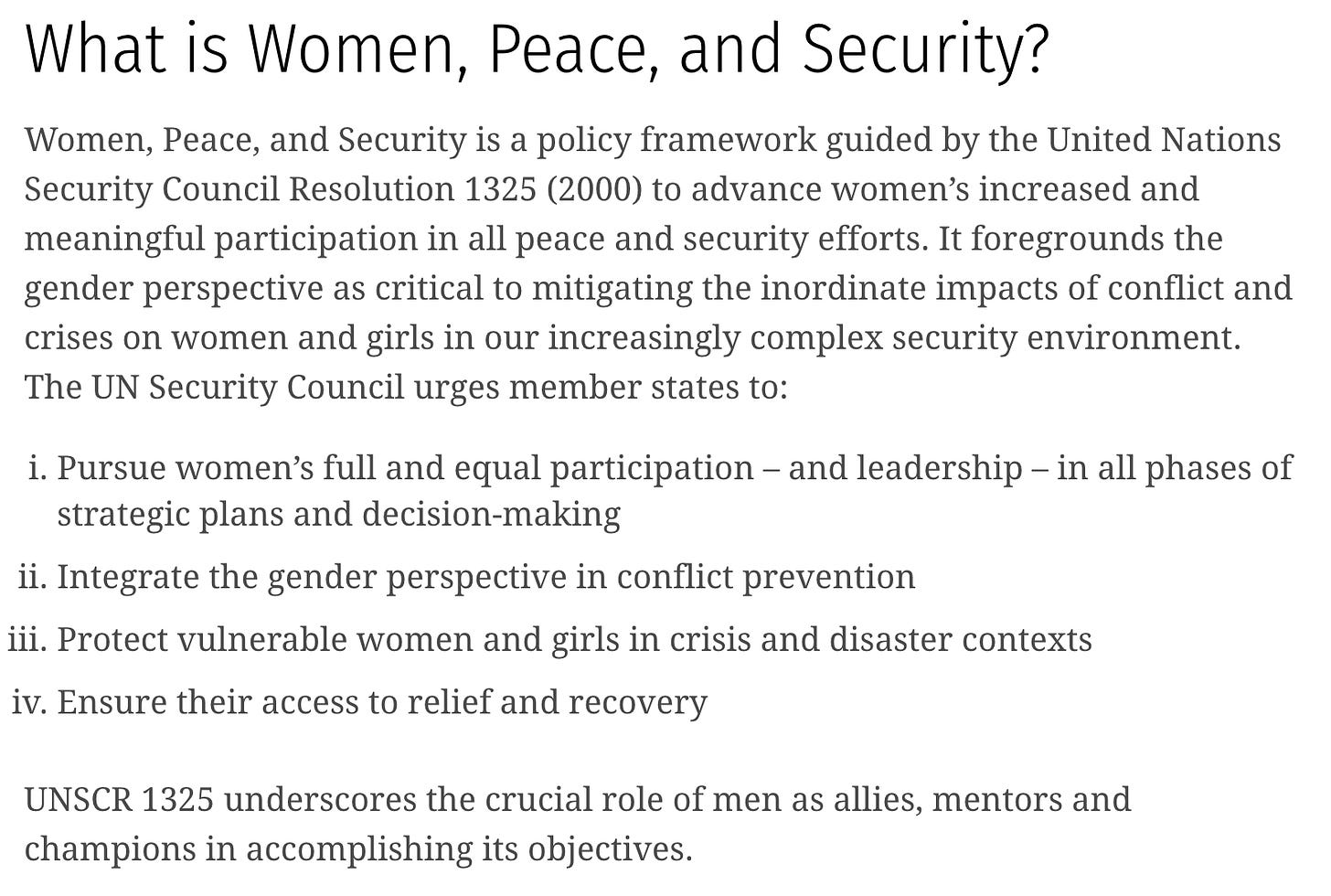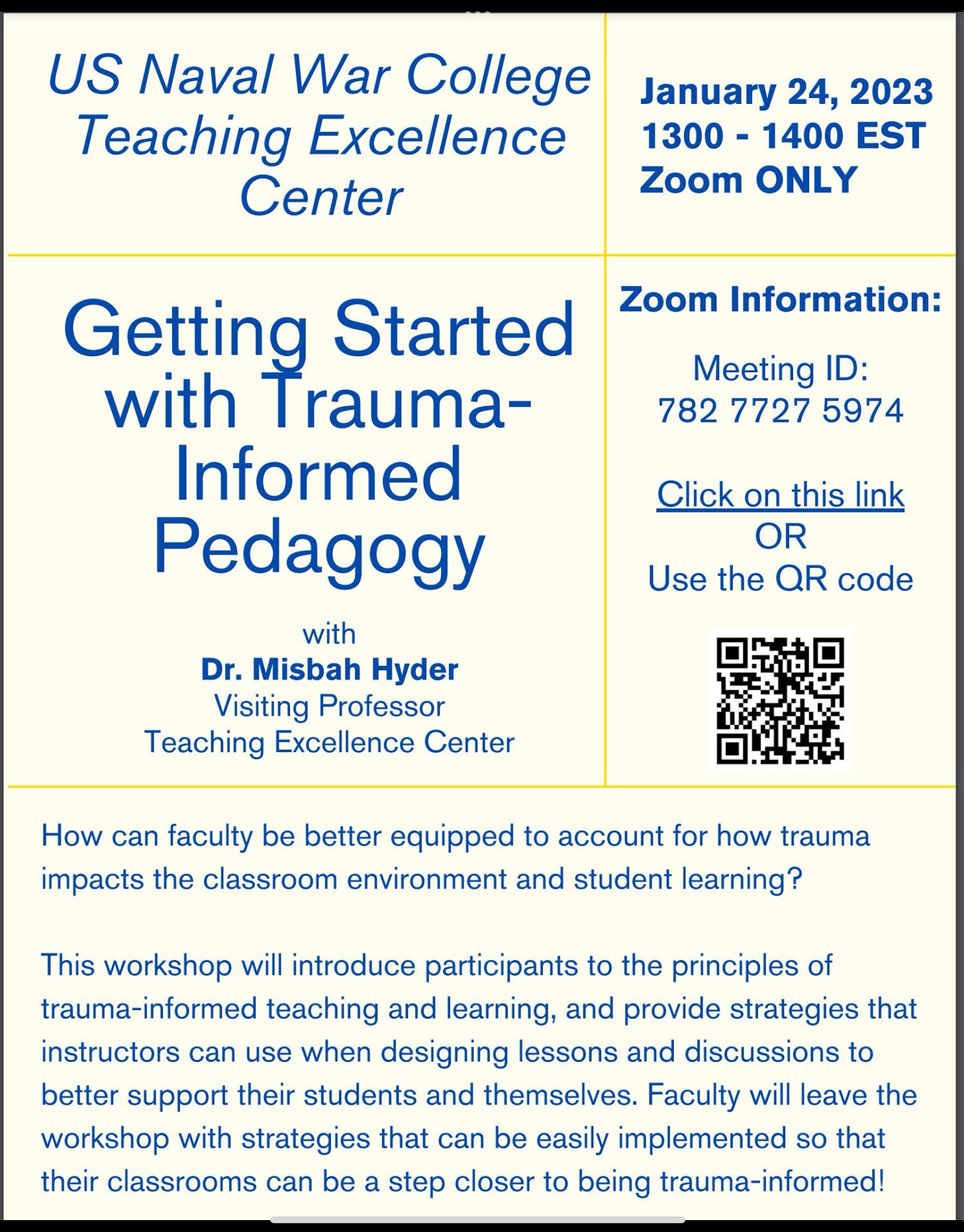I’d like everyone to keep in mind that we have a, as in one, Naval War College (NWC). At a time where from the Black Sea, to the Red Sea, to the Western Pacific - there are serious challenges in the maritime domain unseen since the fall of the Soviet Union, what do you want it focused on?
Take that point and freeze it.
Today I’d like you to ponder if NWC is really a place to invest limited resources to emphasize Gender Studies. Well, too late - it already is.
It started in earnest during the Obama Administration and has been digging its roots deeper ever since.
Gender Studies. Not at Oberlin, but at the Naval War College.
Being that the leftist warping of our institutes of higher learning broke above the background noise the last few months with the events in Harvard, Penn, MIT, and elsewhere, as we’ve picked on USNA enough lately, I guess it is a good time to revisit what the NWC is focused on.
To understand why NWC is all wrapped up in Gender Studies, you need to go back to the United Nations in 2000.
In 2000, the United Nations Security Council (UNSC) formally acknowledged through the creation of Resolution 1325 the changing nature of warfare, in which civilians are increasingly targeted, and women continue to be excluded from participation in peace processes. The resolution specifically addresses how women and girls are disproportionally impacted by violent conflict and war and recognizes the critical role that women can and already do play in peacebuilding efforts. UNSCR 1325 affirms that peace and security efforts are more sustainable when women are equal partners in the prevention of violent conflict, the delivery of relief and recovery efforts and in the forging of lasting peace.
Yes, we’re revisiting the same topic from last November. When you see how Woman, Peace, and Security (WPS) is operationalized at NWC, it is simply a blue and gold tinted Gender Studies program, bringing in the usual raft of politics and side-issues with it. Might as well get to know it, you’re paying for it in both money and the opportunity cost diverted away from … well … everything else you’d prefer your mid-to-late-career naval officers investing their time in.
WPS born at the UN marched its way in to law in the USA over the next 17 years.
This was a project of the Obama Administration that - like most government programs - once started and if not resisted, just keep going on inertia and year after year accrue more money and its supporters try to spot-weld power for themselves and their mission.
In the USA, it all kicked off on 19 December, 2011 with the person on point for the project, Hillary Clinton.
That is why this morning, President Obama signed an Executive Order launching the first-ever U.S. National Action Plan on Women, Peace, and Security – a comprehensive roadmap for accelerating and institutionalizing efforts across the United States Government to advance women’s participation in making and keeping peace. This plan builds on the President’s national security strategy, and it was jointly developed by the Departments of State and Defense, USAID, and others with guidance from the White House. I also want to take a moment to recognize all our partners in civil society and the private sector who contributed, many of whom are here today. Without your on-the-ground experience, your passionate commitment, and your tireless effort, this plan would not exist, and we look forward to working just as closely together with you on implementing it.
The core of the plan is simply … well … like Clinton’s State Department said;
A key objective of the NAP is involving
A key objective of the NAP is involving women in conflict resolution. When women are meaningful participants in peace processes and decision-making forums, they can enlarge the scope of agreements and put the focus on issues such as human rights, justice, reconciliation and economic renewal that are critical to sustaining peace.
I’d encourage folks to read the National Action Plan linked below. Everything that follows makes sense from there to understand why NWC finds itself fully emmeshed as a vanguard of a political project;
The United States adopted its first National Action Plan in 2011, which was signed by President Barack Obama through Executive Order 13595. Although women’s protection and participation had been referenced in previous foreign policies, the U.S. NAP was the first legal and policy framework to recognize women’s inclusion as a central aspect of U.S. conflict prevention and resolution efforts. Its structure is also significant as it was developed and implemented by a broad interagency group.
The U.S. NAP mandated an annual review for a progress report to the President, along with a comprehensive review every five years. In 2016, the U.S. Government adopted a second NAP following a review process in consultation with civil society to address challenges and lessons learned from initial implementation.
…
On October 6, 2017, the Women, Peace, and Security Act of 2017 was signed into law (Public Law No: 115-68) by President Donald Trump replacing the existing NAP framework. ... A government-wide strategy on Women, Peace, and Security is required by the Act and will be implemented through interagency coordination, policy development, enhanced professional training and education and evaluation, among other approaches.
As President Trumps signature in 2017 shows, this political project of the Obama Administration quickly became a bi-partisan project.
The U.S. National Action Plan on Women, Peace, and Security builds upon the goals for gender integration described in the U.S. National Security Strategy and the 2010 Quadrennial Diplomacy and Development Review. Gender integration involves identifying and addressing, in all our policies and programs, gender differences and inequalities, as well as the roles of women and men. The goal of gender integration or “mainstreaming” is to promote gender equality and improve programming and policy outcomes.
So, lesson to everyone here - regular consistent pressure can turn the political in to policy, changing the discussion of its utility. That was never assumed. In 2012, don’t forget the WPS evangelists had to do the soft sell at NWC and elsewhere. That was the velvet glove, because as anyone who was watching at the time remembers, the iron fist was ready to strike if you did not fully embrace the new civil religion.
NATO is all in as well, which I guess is to be expected.
We’ve established that this long predates the 2017 law signed by President Trump when it comes to WPS getting its nose across the quarterdeck at NWC. This year will the NWC’s 10th WPS conference. That’s 2014. A nice slow roll out that now has quite the head of steam - and has plans to expand further.
I think well meaning people can - and should - discuss if this dedication of resources are the highest and best use of a naval war college. I know The Party only allows praise, but everyone should ponder this on their own. Let’s look at the Call for Papers for the next conference and again, ask yourself that even if Gender Studies is a valid area of study, does it really need to be emmeshed at NWC?
When you dig around many of the WPS documents - and there is a lot of them - you quickly see the game, but I’ll give credit to the NWC WTS cadre - they’re not hiding the ball and are rather up front with it;
The event … examines women’s full and equal participation, decision-making, and leadership, alongside men, in promoting lasting peace and security.
Consistent with approved doctrine. Of course, the major issue is to make sure the right credentialed people get the gigs.
Hmmm… let’s look at the symposium theme,
“Advancing Gendered Security in a Complex World: Hard Power, Smart Power, Soft Power.”
What is included in that?
Climate crisis and severe weather events
Marine pollution
Feminist foreign policies
Popular front politics is a hell of a drug…and because, in the end, we have to get paid;
Recruitment, retention, and promotion policies
Like most of the leftist projects, it is about the larger political agenda and jobs. After all, you cannot expand your march through the institutions unless your properly politically aligned cadres don’t have a paying gig.
Never forget that for the true believers, this is an missionary job where the word must be shared and imposed to the world around you. It isn’t an isolated area of study. For example;
I can’t seem to find “the current WPS lexicon” but we can find some good references to “WPS Key Concepts” and this from the NWC’s WPS website is helpful;
They key points to pull out of that to, “…advance women’s increased and meaningful participation in all peace and security efforts” and to ensure efforts “foregrounds the gender perspective” - when means it is up front.
Yes, I’m repeating myself. As the Navy taught me, that is how you make sure the important things will be remembered.
I’m not sure if anyone is allowed to ask the question, “What is a Woman” - but I digress.
Just to be clear here, they want their politicized world view everywhere.
That’s right, Shipmate - everywhere at NWC.
As I can’t find if the zoom event was recorded, we’ll just have to rely on the fountainhead, the UN, for the quick explainer.
If someone is getting pushback on integrating WPS in the classroom, a visiting professor who just finished up her PhD, working from the “Teaching Excellence Center” (who BTW has some curious views on the events following the slaughter of October 7th), can help you with that;
Speaking of which, this leads us down yet another rabbit hole.
What is a “Trauma-Informed Pedagogy?”
Barnard College, natch, has a workable definition;
Trauma-informed pedagogy originally grew out of research on post-traumatic stress disorder among veterans, and it has also been influenced by research on intergenerational trauma, sexual violence and assault, and more recently by the impact of COVID-19 on college students. “The coronavirus pandemic,” Marquart and Báez argue, “has served as a catalyst for faculty to adopt trauma-informed teaching and learning (TITL) practices, as educators across disciplines have shifted their teaching to be more compassionate, flexible, consistent, and predictable in response to the worldwide trauma and distress” (2021, 63). In Fall 2020 and Spring 2021, many Barnard faculty adjusted their courses in ways that align with trauma-informed pedagogies, including compassion and flexibility (e.g., giving students more time to complete exams or replacing exams with alternative assignments, granting students grace periods on their work, offering students options in how they demonstrate learning). Faculty also made time for consistent check-ins with students, and considered the effects of the pandemic on students’ capacity to retain and process information. Many students reported these positive changes in the Fall 2020 and Spring 2021 Virtual Learning Surveys, and the CEP recommends continuing these practices both for supporting students as they encounter distress, trauma, and anxiety in their daily lives. These principles would ideally be enacted at all times, and faculty may return to these principles with renewed attention during moments of international, national, or local crises, including acts of violence that impact our community members.
Spend some time on that Barnard page. I’d just love to see “Content Advisory Statements“ at the beginning of every course at NWC.
Meanwhile, how are we doing thinking about the next “unexpected” developments at sea?











Gah!! Perhaps our new CNO can get the President of the NWC to actually implement her direction for the Navy?? Have a curriculum that is actually about what the NWC was created for?
It seems that women have made great strides and there are fewer glass ceilings. Even Saudi Arabia now allows women in the army. It seems that the problem is mostly outside what we consider to be (pardon the expression.) civilized cultures and societies. Perhaps we can get some perspective from some female members of Boko Haram.
By analogy, this is like campaigning for the environment and ignoring China and India, while going after countries that are changing.